Introduction to Smoking and Detoxification
Detoxification is a critical step on the path to recovery for those who have experienced substance dependency. While the body’s natural detox functions aim to cleanse harmful substances from vital organs like the liver, kidneys, and lungs, lifestyle choices—such as smoking—can significantly impact this process. This article explores the complexities of smoking during detox, examining its effects on health, withdrawal symptoms, and the body’s ability to eliminate toxins.
The Impact of Smoking on the Detoxification Process
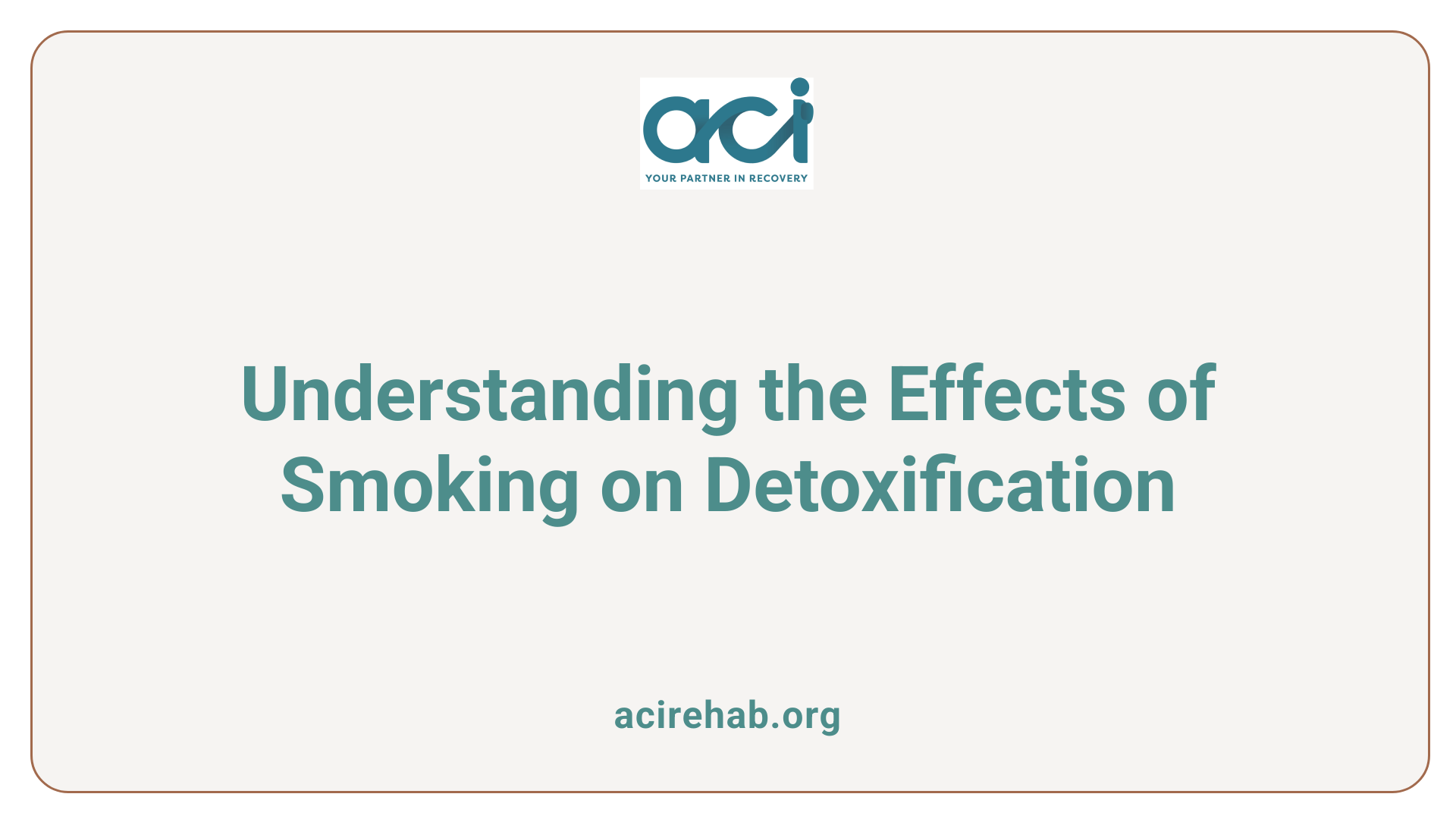
Introduction of toxins through smoking
Smoking introduces harmful substances like nicotine, carbon monoxide, and tar into the body, severely hampering the detoxification process. These toxins can overwhelm the body’s natural detox mechanisms, making it harder for individuals to eliminate both nicotine and other harmful substances simultaneously. As a result, this may result in a prolonged detoxification period, further complicating recovery efforts.
Influence on detoxifying organs
Cigarette smoke can particularly impact the liver and lungs, the two critical organs involved in detoxification. The liver, responsible for metabolizing toxins, can struggle to cope with the added burden of nicotine and other chemicals from smoking. Smoking reduces liver enzyme activity and disrupts metabolic processes, hindering the body’s ability to break down and excrete harmful substances effectively. Meanwhile, smoking irritates the lungs, making them less effective at clearing out toxins, thus compromising the overall detoxification process.
Prolonged detox duration
Research has shown that individuals who smoke during detoxification are more likely to experience intense cravings and withdrawal symptoms, which can prolong the duration of the detox process. The additional stress from nicotine withdrawal, alongside detoxing from other substances, can increase anxiety and irritability. These challenges can lead to higher relapse rates, as individuals may turn to substances as coping mechanisms for managing their discomfort. Ultimately, the presence of nicotine in the body complicates and extends the recovery timeline, highlighting the importance of addressing smoking habits during detox.
| Impact of Smoking on Detoxification | Summary of Effects | Recommendations |
|---|---|---|
| Introduction of Toxins | Overwhelms detox systems | Quit or reduce smoking |
| Organs Involved | Impairs liver and lung function | Consult healthcare providers |
| Prolonged Duration | Heightened cravings and relapse risk | Utilize smoking cessation support |
Health Risks of Smoking During Detox
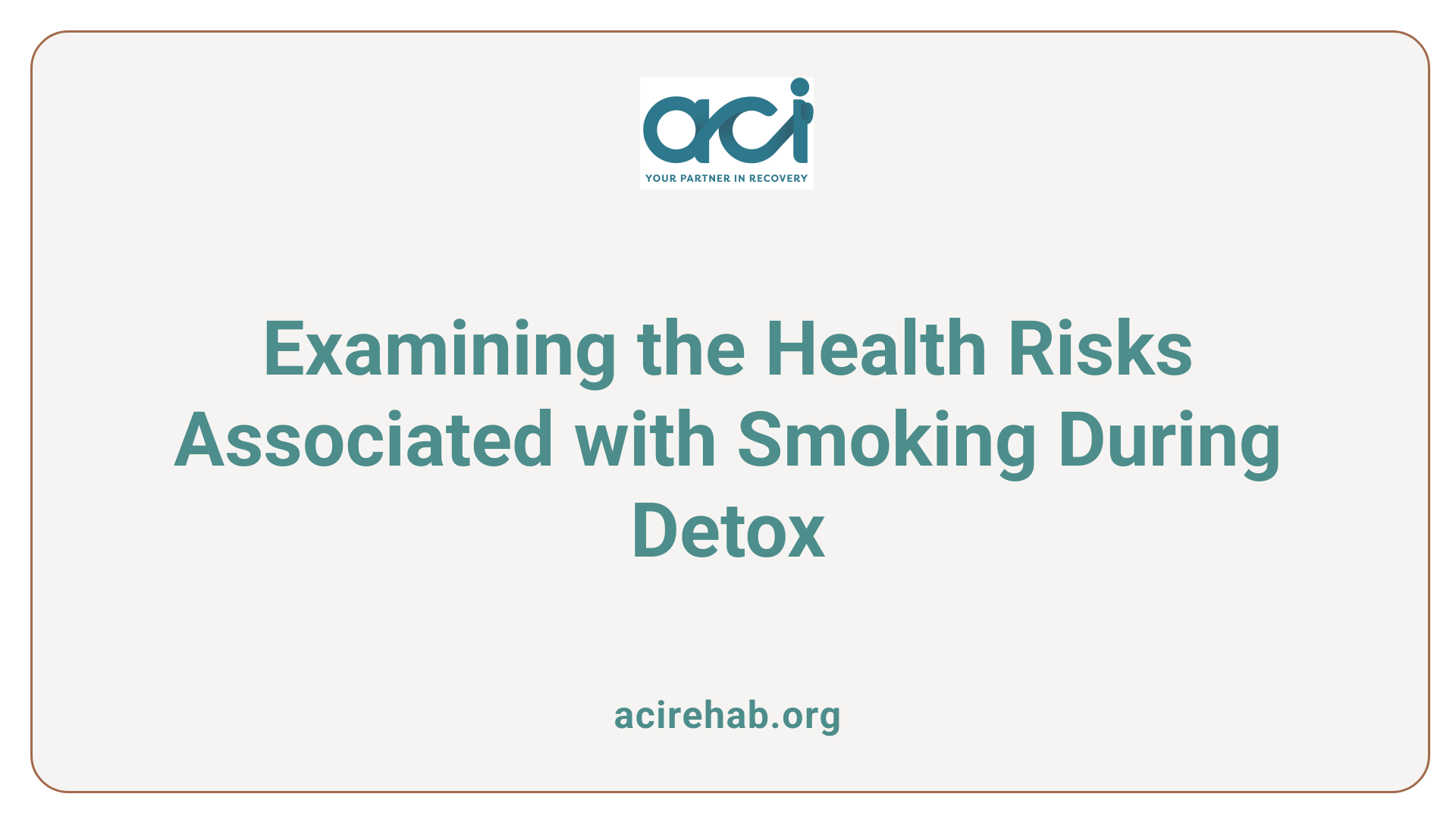
What are the health risks of smoking while detoxifying?
Smoking during detoxification poses significant health risks that complicate the recovery process. When individuals smoke, they introduce additional harmful toxins such as nicotine and carbon monoxide into the body, which can hinder the detoxification process itself. This interference slows the elimination of existing drugs or toxins from the system and compromises lung function, making it harder for the body to expel these harmful substances effectively.
The impact on organ health is particularly concerning. Smoking reduces blood flow and oxygen delivery to vital organs, especially the liver and kidneys, which play critical roles in metabolizing and excreting toxins. As a result, the liver’s ability to detoxify the body is impaired, and this may lead to a buildup of harmful substances, prolonging the detoxification period. Additionally, the irritative effects of smoking on lung tissue can lead to inflammation and reduced lung capacity, further hindering the body’s natural detox mechanisms.
Implications for Recovery
Moreover, smoking can exacerbate withdrawal symptoms related to other substance use, such as anxiety, irritability, and restlessness. The nicotine addiction itself can trigger cravings for other addictive substances, complicating the overall recovery effort and increasing the risk of relapse. Individuals already dealing with cravings from detoxification may find their psychological and physical challenges intensified by the need to smoke.
In summary, continuing to smoke while detoxifying delays the overall benefits of recovery, such as improved lung function and better health. Therefore, it is advisable to seek guidance from healthcare professionals on how to manage tobacco use during this critical time of healing.
Withdrawal Symptoms and Smoking During Detox
How can smoking affect withdrawal symptoms during detox?
Smoking during the detoxification process can complicate the experience significantly. The withdrawal symptoms associated with quitting nicotine can overlap with those of other substances, intensifying discomfort. Common withdrawal symptoms include:
- Cravings: Intense urges for nicotine can distract from cravings for other substances, increasing the likelihood of relapse.
- Irritability: A person may experience heightened irritability, making interactions and recovery more challenging.
- Anxiety: Anxiety levels can rise, complicating the emotional landscape during detox.
- Difficulty concentrating: The combination of nicotine withdrawal and the focus on detoxing from other substances can hinder cognitive function.
Inciting cravings and complications
Additionally, smoking can provoke cravings for other addictive substances. This phenomenon occurs due to the interrelated nature of various dependencies. The body often substitutes one substance for another, making quitting smoking particularly difficult during detox. Environmental triggers, such as being around other smokers, may amplify these cravings, underscoring the need for robust support systems to mitigate relapse risks.
Management of withdrawal
Managing withdrawal symptoms is paramount for individuals undergoing detox. Strategies can include:
- Nicotine Replacement Therapy (NRT): This approach uses patches or gum to help gradually ease withdrawal symptoms.
- Behavioral support: Counseling and peer support groups can provide emotional guidance.
- Physical activity: Engaging in regular exercise can significantly alleviate withdrawal symptoms and improve mood.
- Good sleep hygiene: Establishing a regular sleep schedule can help combat insomnia and promote recovery.
Addressing both nicotine dependence and the detoxification from other substances is essential for fostering a smoother, less strenuous recovery path.
Managing Tobacco Use During Detoxification
What strategies can help manage tobacco use during detox?
Managing tobacco use during detoxification involves a combination of gradual reduction strategies and support therapies. Gradually reducing smoking can ease withdrawal symptoms, making the process less daunting. It allows the body to adjust to lower levels of nicotine without overwhelming it with cravings.
Utilizing nicotine replacement therapies (NRT) is another effective approach. Products such as gums, patches, or lozenges deliver controlled doses of nicotine, aiding in the management of cravings and withdrawal effects. This method helps individuals taper off nicotine more comfortably.
Behavioral therapies play a crucial role as well. Techniques like Cognitive Behavioral Therapy (CBT) and Motivational Interviewing (MI) help individuals identify triggers for smoking and develop coping strategies to prevent relapse. These therapies focus on changing thought patterns and improving decision-making skills, which are essential during detox.
Support Therapies
Having a robust support system is vital during this phase. Support groups, counseling, and resources like SAMHSA’s National Helpline provide connections to treatment options and assistance from peers who understand the challenges involved.
Engaging in physical activities and practicing relaxation techniques can effectively mitigate withdrawal symptoms. Activities like yoga, meditation, or simple regular exercise support not only physical health but also emotional resilience during the detox process.
Building a Supportive Environment
Creating a smoke-free environment is essential for enhancing the detox experience. Surrounding oneself with supportive friends and family who encourage quitting is beneficial. Consider establishing smoke-free zones at home or in social activities to reduce the temptation.
Overall, integrating these strategies can help strengthen individuals’ resolve while enhancing their ability to manage nicotine cravings effectively. Relapsing is a real concern, but with the right support and strategies, the journey through detox becomes an opportunity for complete recovery and improved health.
Smoking’s Effect on the Liver and Kidneys During Detox
How does smoking affect liver enzymes during detox?
Smoking complicates the detoxification process by altering the function of liver enzymes that are crucial for breaking down substances. This alteration can increase the body’s toxin load and delay the elimination of drugs, alcohol, or other harmful chemicals. By affecting enzyme activity, smoking prolongs the time needed for detoxification and recovery.
Impact on kidney function
The kidneys play a vital role in filtering waste products and excess substances from the body. Smoking can impair kidney function by constricting blood vessels and reducing blood flow, which is essential for effective filtration. This compromised kidney function can hinder the elimination of toxins and pose added stress on the body during detox.
Overall organ strain
Together, the liver and kidneys work to detoxify the body. Smoking introduces a variety of harmful toxins, increasing the burden on these organs. As the liver metabolizes nicotine and other chemicals from cigarettes, its ability to process and eliminate other toxins diminishes. This combined strain can lead to a slower detoxification process and prolong withdrawal symptoms, complicating recovery efforts.
| Organs | Impact of Smoking | Consequence |
|---|---|---|
| Liver | Alters enzyme function | Delays toxin elimination |
| Kidneys | Reduces blood flow and filtration efficiency | Compromised ability to excrete toxins |
| Overall | Overburdened by additional toxins | Prolonged detoxification and withdrawal |
Challenges of Smoking on Lung Health and Detoxification
How does smoking affect lung health during detox?
Smoking poses significant challenges to lung health, especially during the detoxification process. The act of smoking introduces harmful chemicals, such as nicotine and tar, that can irritate lung tissue, leading to inflammation and damage. This irritation hampers the lungs’ natural ability to cleanse themselves of toxins, which is critical during detox.
Furthermore, the inflammation caused by smoking can result in reduced efficiency when expelling toxins and other harmful substances. As the lungs struggle with the added burden of nicotine and other toxins from cigarettes, their capacity to support the body’s detoxification processes diminishes.
This not only prolongs the detoxification process but also increases the risk of respiratory diseases. A compromised lung function can make individuals more vulnerable to infections and other health complications, complicating their overall recovery efforts.
In summary, smoking undermines lung health during detox, impairing the lungs’ cleansing capabilities and making it harder for the body to rid itself of other substances. It’s crucial for individuals undergoing detox to consider the detrimental effects of smoking on lung health and overall recovery.
Relapse Risks and Smoking While Detoxing
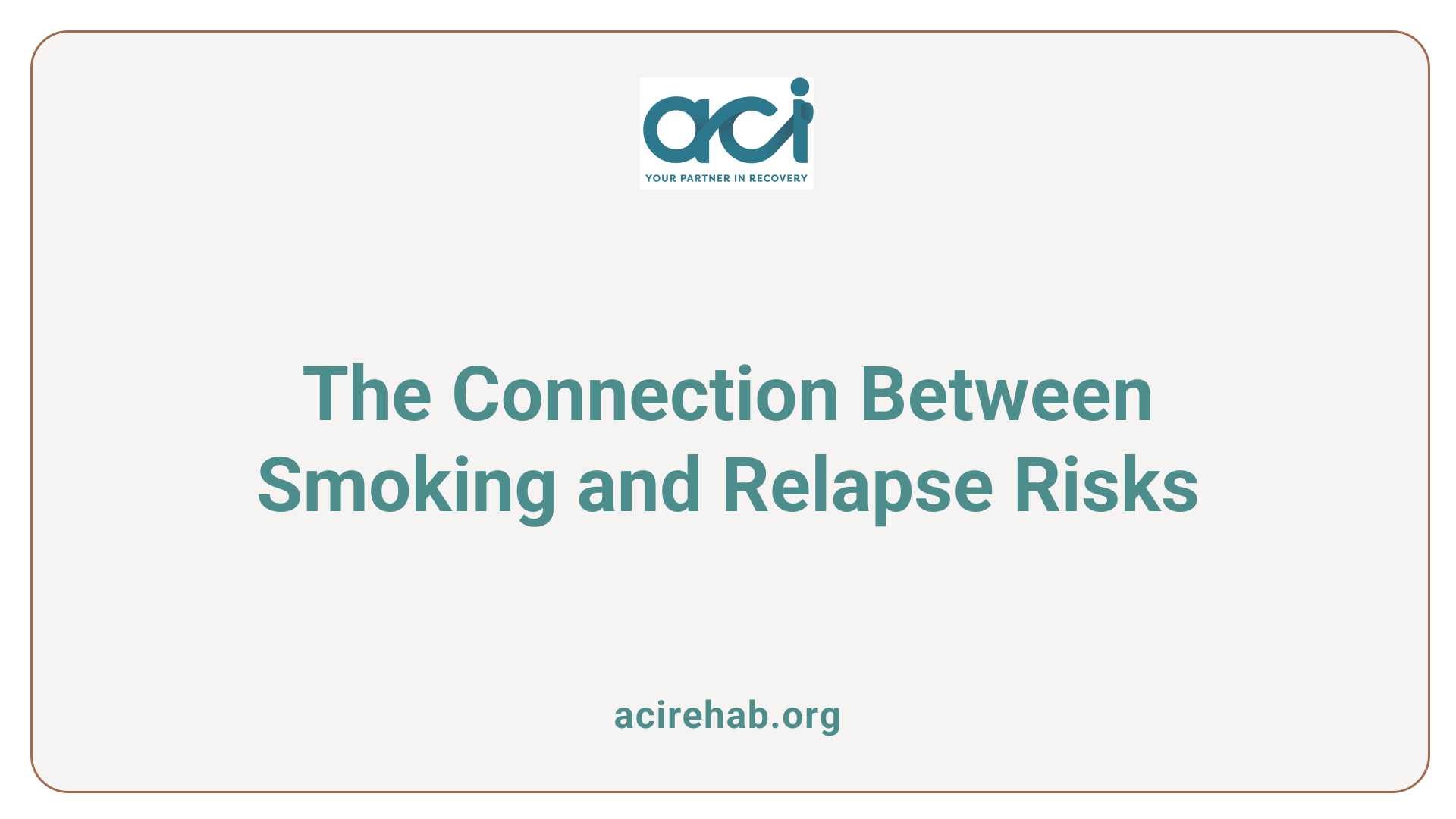
How does smoking during detox increase relapse risks?
Smoking during detox can significantly increase the likelihood of relapse due to several intertwined factors. First and foremost, smoking can trigger cravings for other addictive substances. This is particularly concerning as individuals in recovery are already battling cravings related to their primary substance of abuse.
When nicotine enters the body, it stimulates dopamine production, which may provide temporary relief from withdrawal symptoms. However, this relief is short-lived and can lead to intensified cravings for other drugs or alcohol, creating a cycle of dependency.
Additionally, smoking can heighten withdrawal discomfort, making it harder for individuals to cope during the detoxification process. Symptoms such as anxiety and irritability can become more pronounced when someone is smoking, which can further complicate their recovery journey.
This increased discomfort may drive individuals to seek further relief, potentially leading them back to the very substances they are trying to detoxify from. Research suggests that people who smoke during detox experience higher withdrawal symptoms and cravings compared to non-smokers, thus reinforcing the connection between smoking and increased relapse risks.
| Risk Factor | Description | Impact on Recovery |
|---|---|---|
| Increased Cravings | Smoking can trigger cravings for other substances. | Heightens the risk of returning to substance use. |
| Withdrawal Discomfort | Exacerbates symptoms of anxiety and irritability. | Makes coping with detoxification more difficult. |
| Cycle of Dependence | Smoking provides temporary relief from withdrawal. | Increases the likelihood of seeking additional substances. |
Engaging with healthcare providers for comprehensive support, including smoking cessation resources, can help mitigate these relapse risks during detoxification.
Nicotine Withdrawal Management During Detoxification
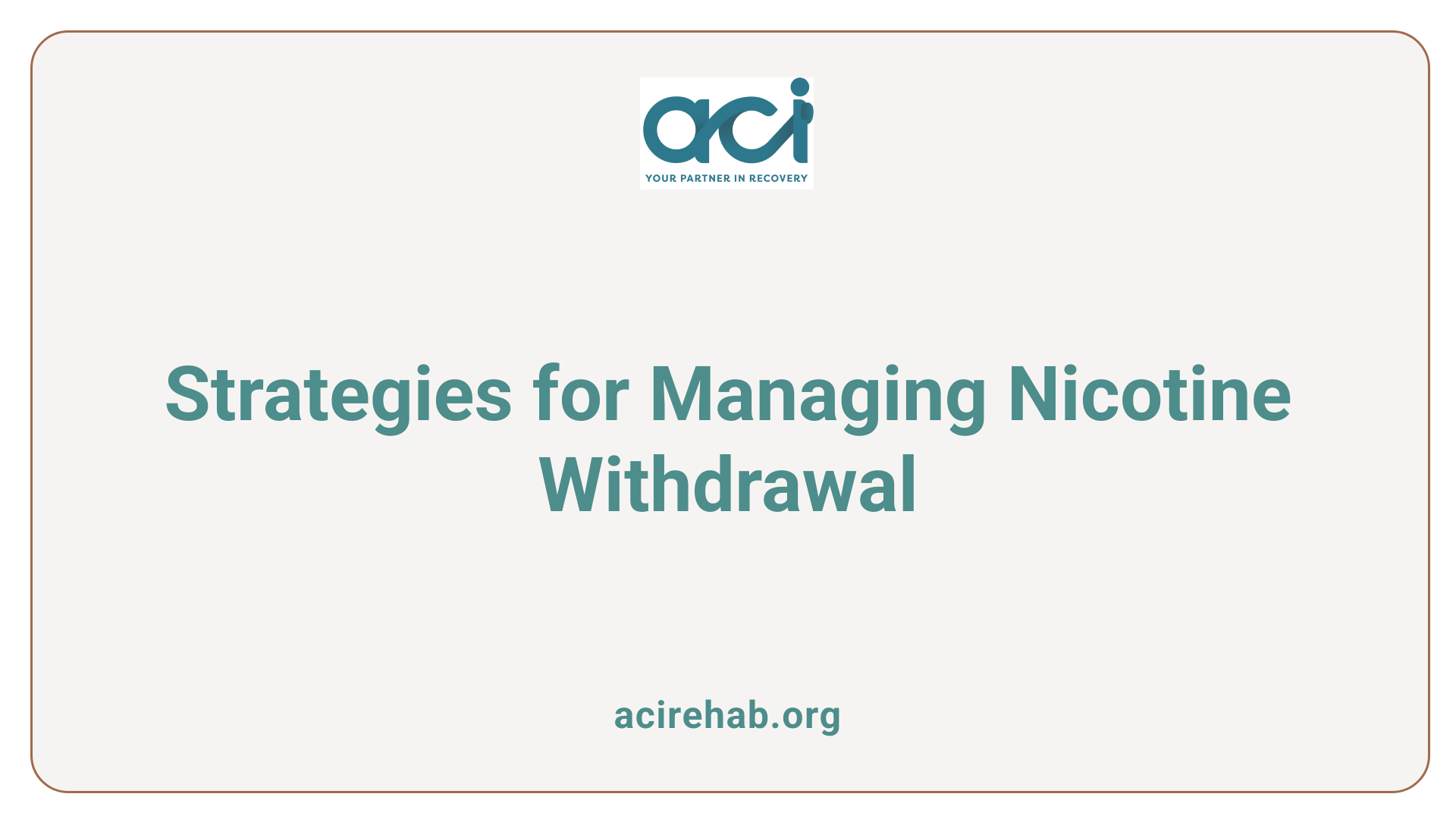
What are common symptoms of nicotine withdrawal?
Managing nicotine withdrawal is an essential aspect for individuals undergoing detoxification. The symptoms can vary but commonly include irritability, increased anxiety, restlessness, cravings for nicotine, difficulty concentrating, and disrupted sleep patterns. These symptoms can significantly hinder the detox process if not addressed properly.
What are effective methods to manage nicotine withdrawal during detox?
Effective methods for managing nicotine withdrawal include:
- Nicotine Replacement Therapy (NRT): This involves using products like patches, lozenges, or gum to help reduce cravings and ease withdrawal symptoms.
- Behavioral Support: Engaging in cognitive behavioral therapy (CBT) can provide strategies to cope with cravings and manage stress.
- Non-narcotic Medications: Some medications can be prescribed to mitigate anxiety and other severe withdrawal symptoms during detox.
- Stress Management Techniques: Practicing relaxation techniques, such as mindfulness or yoga, can help alleviate anxiety and improve concentration.
- Hydration and Nutrition: Maintaining proper hydration and a balanced diet can support overall health and minimize withdrawal symptoms.
By employing these methods, individuals can navigate the challenges of nicotine withdrawal more successfully while focusing on their overall recovery during detox.
Integrating Smoking Cessation Support in Detox Programs
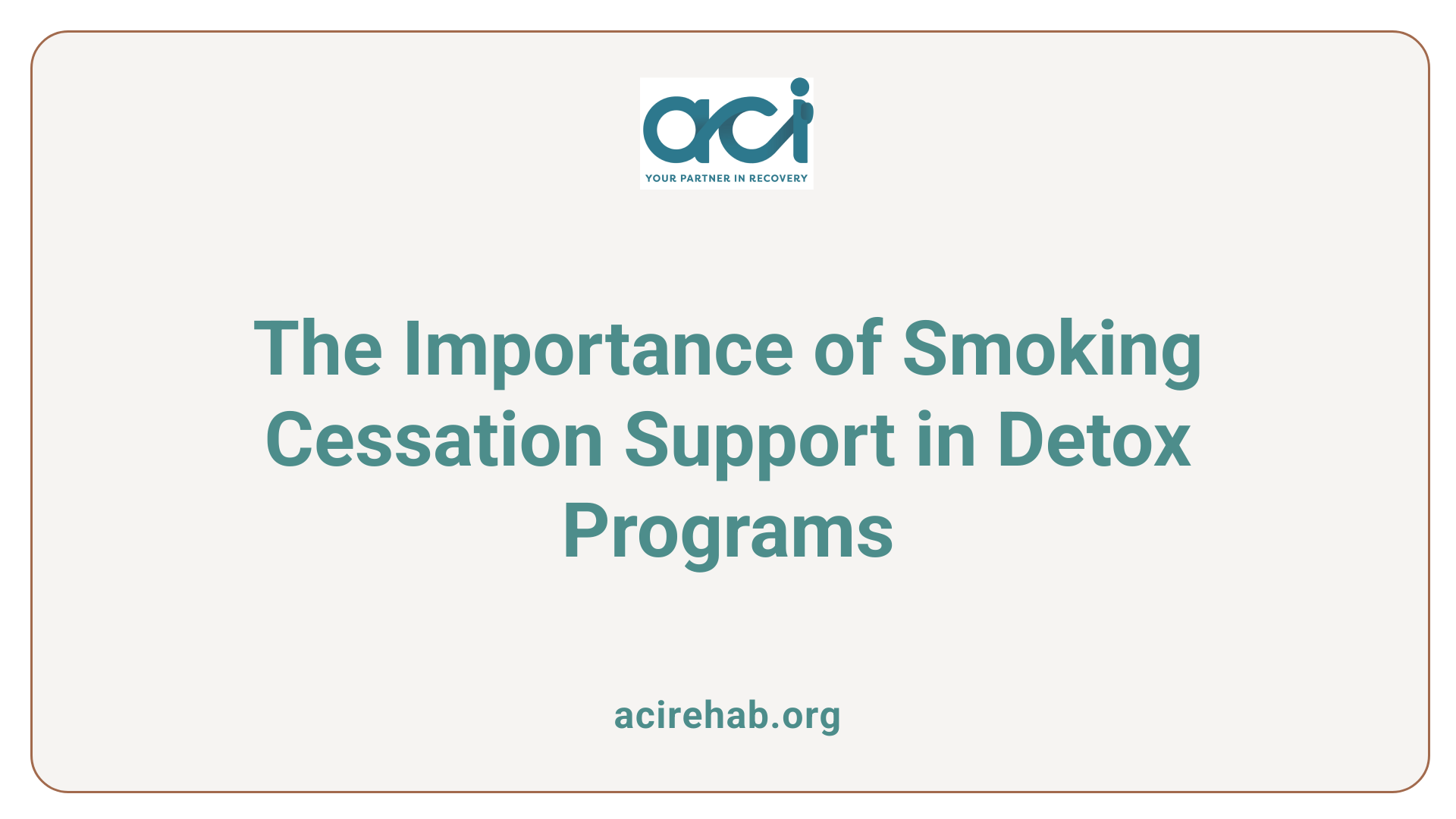
What Role Does Smoking Cessation Play in Detox Programs?
Smoking cessation is considered a vital element within detox programs. The process involves introducing a range of supportive interventions tailored to help individuals quit smoking while clearing other substances from their systems.
Key smoking cessation services often include:
- Counseling: Individual or group sessions help address underlying cravings and behaviors associated with smoking.
- Nicotine Replacement Therapy (NRT): Products such as patches, gums, and lozenges can assist in managing withdrawal symptoms.
- Medications: Certain prescription medications target nicotine withdrawal, making the quitting process more manageable.
- Behavioral Support: Techniques like Cognitive Behavioral Therapy (CBT) can help clients develop coping strategies to resist smoking triggers.
These interventions are designed to achieve several outcomes:
- Reduce Toxin Exposure: Quitting smoking allows the body to focus on detoxification without the added burden of harmful chemicals from cigarettes.
- Support Recovery: By addressing nicotine dependence, patients can experience improved overall health, enhancing the effectiveness of detox programs.
- Decrease Relapse Risks: Evidence suggests that addressing smoking addiction reduces the likelihood of returning to other substance use, promoting a more comprehensive recovery strategy.
As healthcare providers work to personalize detox programs, integrating smoking cessation support proves essential for optimizing health outcomes and aiding in long-term sobriety.
The Role of Vaping as an Alternative During Detox
Vaping Compared to Smoking
Vaping has emerged as a popular alternative to smoking cigarettes, particularly among individuals undergoing detoxification from other substances. One of the primary benefits of vaping is that it typically exposes the user to fewer harmful toxins compared to traditional cigarettes. This is because most e-cigarettes do not contain tar and many of the carcinogenic chemicals found in cigarette smoke.
However, it’s important to note that vaping is not entirely risk-free. While it may reduce exposure to some harmful substances, it still delivers nicotine, which can perpetuate addiction. For individuals already struggling with substance abuse, maintaining any form of nicotine dependency might complicate their overall recovery efforts.
Effectiveness and Potential Risks
Despite being viewed as a potential harm reduction strategy, the effectiveness of vaping in a detox setting is still subject to debate. The lack of definitive research on how vaping impacts the detox process raises concerns about its safety and effectiveness.
Furthermore, while some individuals may find relief from nicotine withdrawal symptoms through vaping, it could also serve as a crutch, delaying the eventual cessation of nicotine altogether. Therefore, while vaping can provide comfort during detox, it’s vital for individuals to weigh its risks and consult healthcare professionals for tailored advice regarding its use during recovery.
Considerations and Recommendations for Smokers in Detox
Mitigating Negative Impacts
For individuals undergoing detoxification, smoking can complicate the process significantly. It is advised to quit or at least reduce smoking during detox to enhance the body’s ability to eliminate toxins more effectively. The harmful chemicals introduced by smoking can increase the toxic burden on vital organs like the liver and lungs, impeding their detoxification roles.
To address nicotine cravings, incorporating strategies such as nicotine replacement therapy (NRT) or behavioral support can be beneficial. These methods help mitigate withdrawal symptoms like irritability, anxiety, and difficulty concentrating, allowing a smoother detox experience.
Healthcare Consultations
Consulting healthcare professionals during detox is crucial. These providers can offer tailored support and guidance based on individual needs, helping manage both the detox process and nicotine addiction. Detox programs often emphasize the need to incorporate smoking cessation support, which plays a significant role in enhancing overall recovery outcomes.
As smoking contributes to prolonged withdrawal symptoms and complicates recovery, working with healthcare experts ensures that individuals receive comprehensive care, thereby increasing their chances of achieving long-term sobriety.
Conclusion: Weighing Smoking’s Role in Detox
While smoking might be permitted in certain detox environments to ease other withdrawal symptoms, its negative impact on the detoxification process is considerable. Balancing the need for comfort with the overarching health goals of detox requires careful management and often professional guidance. By understanding the complex interplay between smoking and detox, individuals can make informed decisions that enhance their recovery journey, promoting long-term health and sober living.
References
- Can You Smoke While Detoxing? – Wellbrook Recovery
- Can You Smoke While Detoxing? – Coachella Valley Recovery Center
- Can You Smoke While Detoxing? – Townsend
- Can You Smoke Cigarettes While Detoxing – LifeSync Malibu
- Can You Smoke While Detoxing? – Clear Steps Recovery
- Navigating Detoxification And Smoking – Northstar Behavioral Health
- Can You Smoke While Detoxing? – Steps to Recovery

